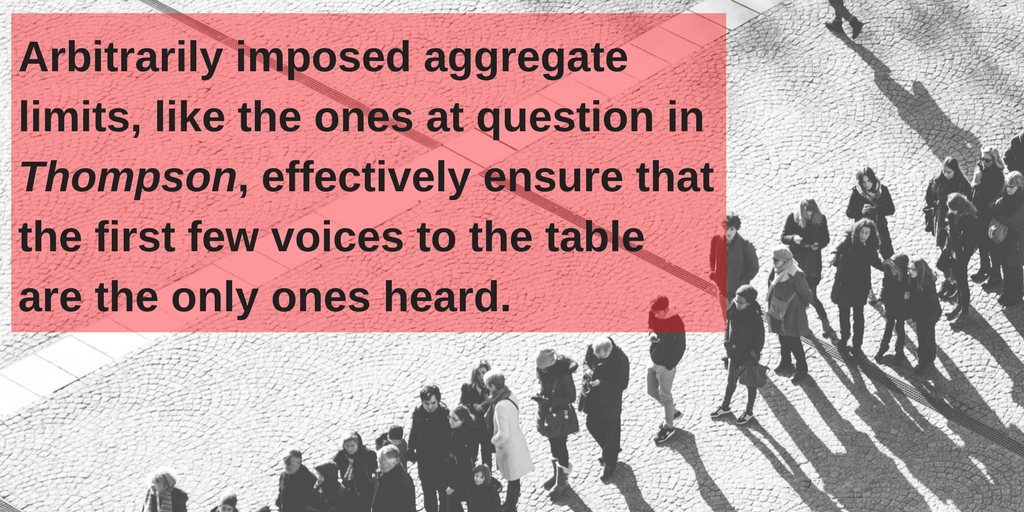There is much talk of media bias in Red America (and a mix of countercharges and defensiveness in Blue). It likely began with the names themselves, with a Red-state claim that it was a biased elite that thought better of saddling a 21st-century Democratic party with the red of the 20th-century; giving “Red” to the right and “Blue” to the left.
Red America “knows” The West Wing’s take on issues, and “knew” Geena Davis’s true role in Commander in Chief. It suspects that Big Love awaits Mitt Romney in 2008, and looks forward in frustration to Frontline pieces on post-traumatic stress disorder: “How are veterans managing decades after Viet Nam?”; or, if necessary, Dateline segments on profiteering by Big HMOs. Red America expects to be asked every morning on Today “Can a woman be elected President in this country?” but never to be asked “Should this woman be elected President of our country?” Red America “knows” there is bias in entertainment, and suspects that it extends to news.
Blue America tends to see bias in the fact of ownership. It is suspicious of the information coming from NewsCorp., Sinclair Broadcasting, and others.
Both suspicions are confirmed to some degree by UCLA political science professor, Tim Groseclose, and CCP Academic Advisor and Missouri economics and public affairs professor, Jeffrey Milyo, who have published a summary of a larger article in the latest issue of Critical Review. Vol. 17, Nos. 3-4, p.305 (2006).
Professors Grosclose and Milyo focus on the news media, not entertainment. They define an ideological slant in many ways: Republican versus Democrat; liberal versus conservative; or on broader assumptions about the causes of social or economic problems, and assume that such a slant, if it exists, is either to the left or right. They begin by noting that journalists are extremely likely to self-identify as being ideologically left, and vote overwhelmingly Democratic. Even former Washington Post political reporter Thomas Edsall has said “[t]he mainstream media presents itself as unbiased, when in fact there are built into it many biases, and they are overwhelmingly to the left.” Howard Kurtz, “Clinton’s Finger-Wagging Moment,” Washington Post, Sept. 25, 2006. Edsall believes that reporters vote Democratic by somewhere between 15 to 1 and 25 to 1. Kurtz, supra. The Post has since seen fit to offer Edsall an early retirement package, and Edsall has accepted. Id.
But Groseclose and Milyo believe it is important to focus on output; on what journalists actually say, and on what citizens actually hear. Yet even as they focus on what is said, the professors believe there are weaknesses in studies that focus on reporters’ use of partisan or ideological labels. One weakness is that it is difficult to control for a lack of use of labels. “A journalist’s failure to label someone or something in partisan or ideological terms may successfully convey to the audience a biased version of (what the journalist considers to be) the non-partisan, non-ideological objective truth.” Groseclose and Milyo at 307.
Many content analyses require researchers to make subjective calls about what constitutes “bias,” but Groseclose and Milyo believe they have found at least one study based in objectivity. The study first used polling data to determine which issues are “owned” by the Democrats, and then found, in a random sample of 36,000 articles from 1946 to 1994, that the New York Times has a “significant shift in the types of news stories that are uncovered during the presidential election years, with the direction being toward topics that are more favorable to Democrats.” Id. at 308. The result is more pronounced when the Democrat is an incumbent.
In determining what citizens actually hear, one study demonstrates that “people with greater exposure to news during the 1992 presidential election campaign were more likely to hold incorrectly pessimistic views of the U.S. economy.” Id. at 309. Another study found that, overall, when Fox News Channel entered a market, “it persuaded up to 3-8 percent of non-Republicans to vote Republican.” Id. at 310.
So, if as Groseclose and Milyo conclude, bias surrounds us, the question is: what do we do about it? Do we hold fast to the belief that we can purge debate of bias by increasing professionalism and objectivity in a professional class of journalists while filtering out the noise of 527s, 501(c)’s, talk radio, editorialists and others? Or do we phase out the filters and let citizens hear bias from all quarters? Perhaps Critical Review editor Jeffrey Friedman has the answer in the introduction to “The Bias Issue,” Vol. 17, Nos. 3-4, p. 222 (2006). Says Friedman,
“Given that…all journalists…think that their opinions are true, they must think that alternative points of view are flawed. Therefore, attempts to force them to ‘balance’ their opinions with those alternatives would simply make them produce biased accounts of ‘flawed opinions’ with which they disagree. this form of bias occurs already, and should not be encouraged through the false notion that there is some way to get a ‘fair and balanced’ view of the world that skips the hard part: listening to divergent viewpoints advocated by their best proponents…”
To put all this in constitutional terms, courts that would reserve favored status for the institutional press when it comes to disseminating political news, based on its supposed objectivity, may be operating from a false premise. They may also be exacerbating bias rather than mitigating it.














